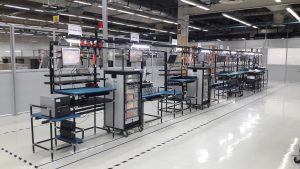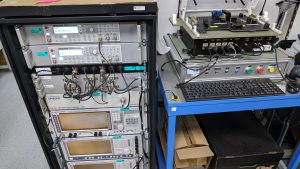5 Characteristics of Leading Industrial IoT Connectivity Solution Providers (Part 2)

Part 2: Supported and verified industrial production processes
By Stephane Dejean – Kerlink CMO
Cities, utilities, public-service agencies and enterprises counting on the Internet of Things to streamline critical business processes and launch new connected services for their citizens, users and customers, face a potentially bewildering array of questions and considerations about how best to proceed. While the goal may be to design, deploy and effectively manage their IoT network, there are many critical steps to arrive there.
With its mastery of the entire IoT connectivity-hardware value chain, its deep expertise in designing and producing hardware and software, and its ability to adapt to customers’ needs, Kerlink has become a global leader in designing and deploying reliable, turnkey networks for public & private customers. We work closely with our customers to provide them with complete solutions for the entire process and unlock the full potential of the IoT for them.
Our five-part series, “5 Characteristics of Leading Industrial IoT Connectivity Solution Providers”, will help cities, companies, utilities and others identify, vet and select the most reliable and responsive partner to achieve their goals quickly and smoothly.
The series:
· Characteristic 1: Exceptional hardware and software product design – Jan. 30
· Characteristic 2: Supported and verified industrial production processes – Feb. 6
· Characteristic 3: Certified overall quality management – Feb.13
· Characteristic 4: Locally supported field operations – Feb. 20
· Characteristic 5: Ongoing excellent customer satisfaction – Feb. 25
Today, we discuss Characteristic 2: Supported and verified industrial production processes
The second characteristic of leading industrial IoT suppliers is the ability to specify, support and verify the entire industrial manufacturing process. In fact, this characteristic continues to be one of Kerlink’s most important areas of expertise. The primary objective of Kerlink’s industrial process is to conceive, specify, and supervise outsourced manufacturing, and test and trace all Kerlink products and subcomponents to ensure maximum quality. Kerlink also patents some of the products, components or capabilities it designs and builds.
As a result of this commitment, customers trust Kerlink for high-quality, reliable, affordable and future-proof industrial hardware and software.
Manufacturing, testing and tracking Kerlink products
Kerlink works with best-in-class regional and global industrial partners to manufacture high-quality hardware.
Its regional partners are known for quality engineering that is supported by the “Made in France” manufacturing label. This network allows Kerlink to multi-source hardware and meet customers’ demanding requirements. Kerlink has three ISO 9001:2015-certified regional partners providing superior IoT products:
- Seprolec, manufacturer of the Devialet Core Infinity high-tier sound system
- Cofidur EMS, manufacturer of the Free Box for the French operator Free, and
- ADEX Electronique, manufacturer of the communications module for the Smoove bike-sharing
Kerlink also relies on global partners to offer scalable industrial manufacturing capabilities, like Flex in India to support deployment of Tata Communications’ LoRaWAN nationwide network. This allows Kerlink to provide its customers with flexible and localized production capacity and support by:
- Setting-up dedicated manufacturing lines for the most highly demanded IoT solutions in the region
- Meeting local regulations or IoT governmental initiatives like the “Made in India” designation, and
- Ensuring uniform, worldwide quality standards as stipulated and validated by

Kerlink’s dedicated product line at Flex’s facility in India – Kerlink © 2018
All regional and global industrial partners participate in Kerlink’s quality-certification programs, under which the company audits how its partners implement Kerlink’s metrics and meet quality levels.
Putting Kerlink products to the test
To ensure exceptional products, Kerlink designs and manufactures test benches to conduct unit testing. These benches capture systemic assembly or design problems through manufacturing and ensure each product strictly and fully conforms to Kerlink’s global quality standards. This process includes test benches placed on the manufacturers’ site, provides software-enabled quality control during manufacturing, supports automated quality control at the end of production, and ensures that onsite quality control is fully part of the manufacturing process.

Kerlink Lab electronic cards test bench – Kerlink © 2019
Kerlink’s quality control program supplements test benches with random auditing of production batches. This unit testing ensures that all products are identical and meet the same tolerances and reliability metrics, and it provides full mastery of quality control across all production volumes, including small batches or specific customer design and / or configurations. It also supports compliance with demanding manufacturing processes for products built by Kerlink’s partners and ensures compliance with global standards for Kerlink’s multinational customers.
No manufactured Kerlink product leaves the manufacturing line without being thoroughly tested at least once.
At the end of Kerlink’s and its partners’ manufacturing lines, Kerlink relies on automated optical inspection (AOI) for its electronic boards and a last look at the final functional product test benches (FFPTB). The company’s manufacturing partners are fully empowered to repair non-conforming products and boards according to documented repair recommendations.
Tracking Kerlink products
Each repaired product is retested before repackaging. The entire quality-control process is saved on the partner’s manufacturing execution system (MES) and shared with Kerlink’s traceability system. Traceability relies on a critical technology integration between Kerlink and its partners.
Kerlink’s product lifecycle-management (PLM) software records and shares software, hardware and prestaging configurations for Kerlink’s partners. Following manufacturing, product data is stored, aggregated and analyzed by Kerlink’s R&D teams in the PLM software.
Manufacturing partners’ MES software records and traces electronic components and boards within the manufacturing process. In addition, it accepts configurations from Kerlink’s PLM software so the partner can build high-quality IoT equipment for Kerlink. During and following manufacturing, MES software shares data with Kerlink’s PLM software.
Overall, this integration allows Kerlink to permanently trace, analyze and control the quality production of its products. This creates a useful feedback loop so Kerlink’s R&D and engineering teams can build continuous improvement into manufacturing processes and identify potential product hardware and software design enhancements.
Since its founding in 2004, Kerlink has a strong history of working with – and carefully listening to – our supply-chain partners and our customers. And we put the best of that experience to work wherever it fits. We are happy to share what we have learned in this five-part series and we will share these articles and more in our whitepaper, “5 Characteristics of Leading Industrial IoT Connectivity Solution Providers” at the conclusion of the series.
See you next week!


